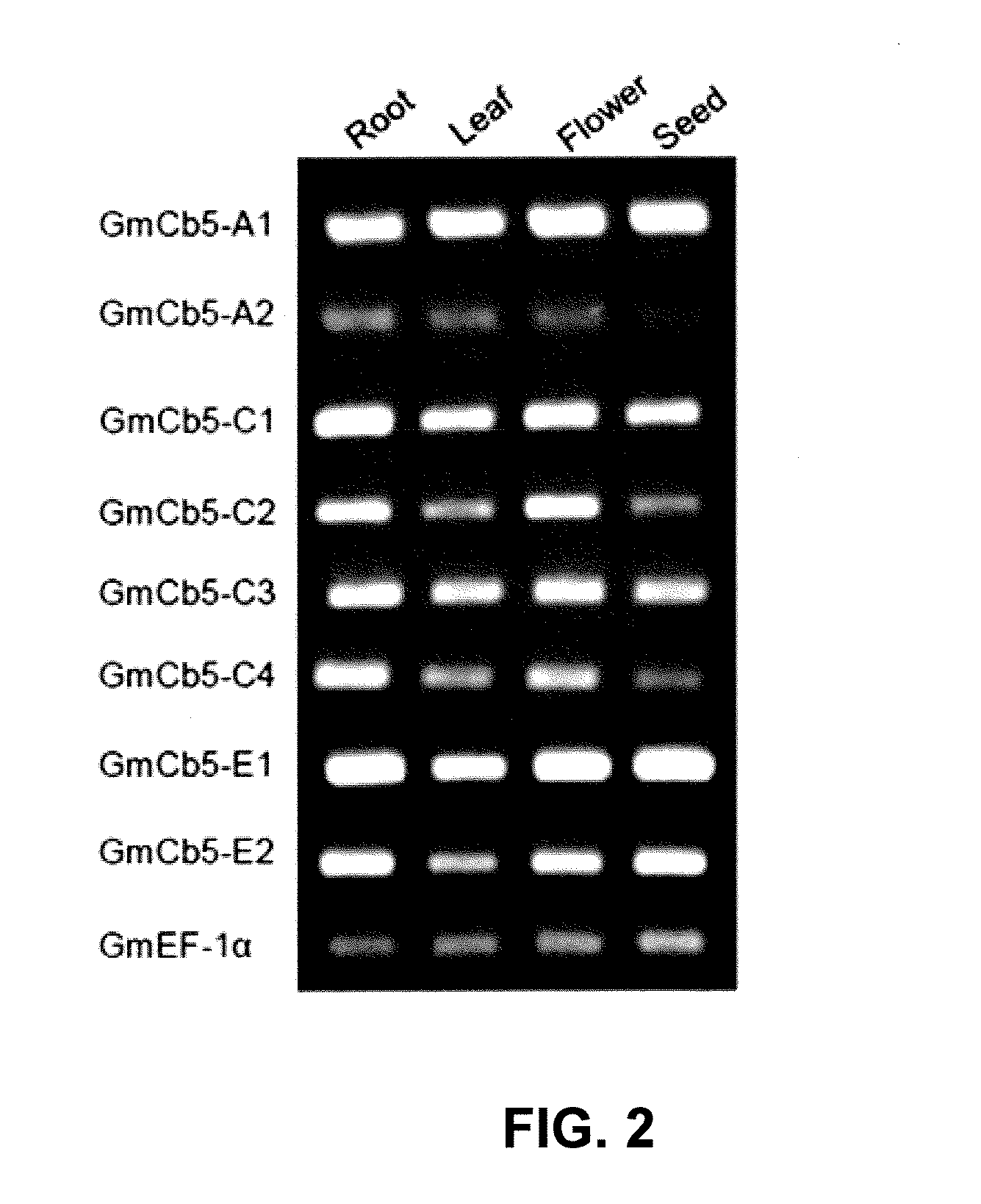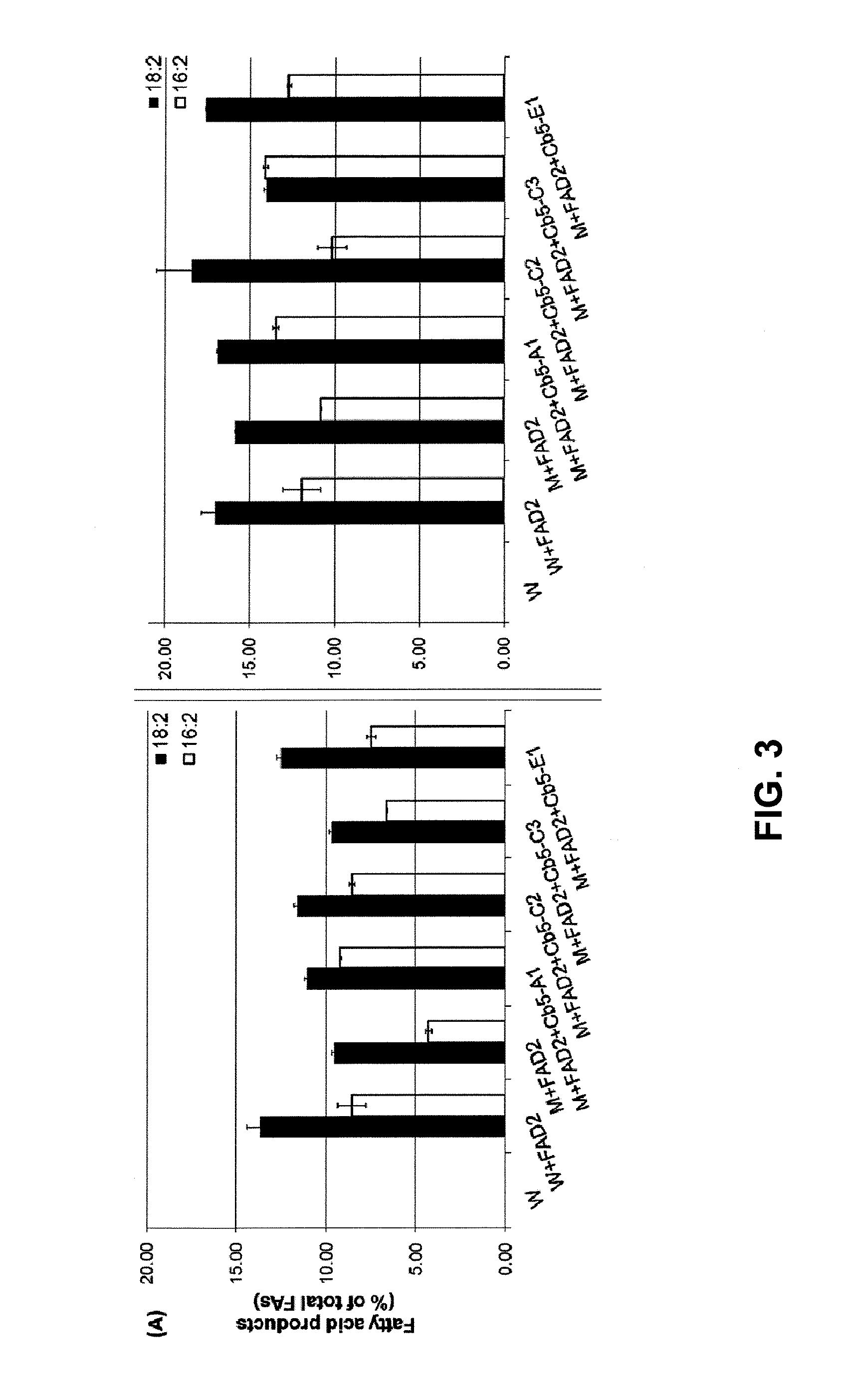Plant Genes Associated With Seed Oil Content And Methods Of Their Use
a technology of plant genes and seed oil, applied in the field of plant genes implicated in oil production, can solve the problems of poor cold flow properties of fuel, less desirable in many applications, and high melting points of saturated fatty acids, and achieves a higher percentage of unsaturated fatty acids and a higher oil content. desirable ratio
- Summary
- Abstract
- Description
- Claims
- Application Information
AI Technical Summary
Benefits of technology
Problems solved by technology
Method used
Image
Examples
example 1
Identification, Cloning and Expression Pattern of Soybean Cb5 Genes
[0081]The public release of nearly complete genome sequence of soybean (Glycine max var. Williams; also available at www.phytozome.org) enabled us to explore Cb5 genes on genome-wide scale. When deduced protein of Arabidopsis Cb5 (At5g53560) was used as query to TBLASTN whole soybean genome, eleven promising Cb5 candidates were identified (Table 2).
TABLE 2Cytochrome b5 (Cb5) genes of soybean(Glycine max var Williams)SEQSequence AccessionNameID. No.NumberGmCb5-A11Gm0096x00349.2GmCb5-A211Gm0065x00536.3GmCb5-B112Gm0119x00133GmCb5-B213Gm0151x00024GmCb5-E14Gm0024x00061GmCb5-E214Gm0037x00062GmCb5-C115Gm0149x00147.2GmCb5-C22Gm0161x00053.2GmCb5-C33Gm0041x00751GmCb5-C416Gm0076x00051.1GmCb5-D17Gm0096x00363
[0082]The predicted protein sequence of soybean Cb5 ORFs (Glyma0 model) shared diagnostic heme-binding motif (-HPGGD-), essential for Cb5 function (data not shown). FIG. 1 shows the phylogenetic relationship of soybean (Glyci...
example 2
Functional Characterization of Soybean Cb5 Genes in Yeast
[0087]Yeast is an excellent experimental system to study FA desaturation as it provides a eukaryotic ER, Cb5, and NADH: cytochrome b5 reductase [25]. Moreover, FA profile of yeast cells are simple, lacks PUFAs typically found in plant oils [28] and can easily take up exogenously supplied FA.
[0088]Yeast Strains, transformation and culture conditions are as described below. The yeast strains used in this study included Saccharomyces cerevisiae Hansen (matα his3 leu2 lys2 ura3; cat# 95400.13Y4742, Invitrogen) and the mutant strain that carried disruption in microsomal Cb5 gene (cat# 95400.17382) in same above genetic background. Yeasts were transformed by Fast-Yeast Transformation kit (G-Bioscience, MO, USA) according to manufacturer's protocol. Transformants were selected from minimal SD agar (Clontech, cat# 630412) plate supplemented with appropriate auxotrophic supplements (-URA DO mixture, Clontech, cat# 630416) maintained at...
example 3
Arabidopsis Cb5 Isoforms Exhibits Differential ω-6 Desaturation
[0094]Arabidopsis has six annotated Cb5 genes at TAM database (www.tair.org) and based on direct and indirect evidence regarding their FR localization [18, 22, 31, 37], four genes viz. Cb5-A (At5g53560), Cb5-B (At5g48810), Cb5-C (At2g46650) & Cb5-E (At2g32720) were selected for this study. Whose sequences are shown in FIG. 11. Among the other two Cb5 genes i.e. Cb5-D (At1g26340) and Cb5-F (At 1 g60660), the former is targeted to outer mitochondrial membrane [31] and the later is quite distinct in having a predicted transmembrane domain at its N-termini as opposed to C-termini typically found with Cb5 proteins [9]. The Arabidopsis Cb5 genes have been implicated in ER based FA desaturation [14] but prior to this study direct evidence regarding their individual contribution in FAs desaturation was lacking. The significant production of di-unsaturated FAs (18:2 & 16:2) in mutant cb5 yeast co-expressing Cb5 genes and native F...
PUM
| Property | Measurement | Unit |
|---|---|---|
| Fraction | aaaaa | aaaaa |
| Temperature | aaaaa | aaaaa |
| Mass | aaaaa | aaaaa |
Abstract
Description
Claims
Application Information
 Login to View More
Login to View More - R&D
- Intellectual Property
- Life Sciences
- Materials
- Tech Scout
- Unparalleled Data Quality
- Higher Quality Content
- 60% Fewer Hallucinations
Browse by: Latest US Patents, China's latest patents, Technical Efficacy Thesaurus, Application Domain, Technology Topic, Popular Technical Reports.
© 2025 PatSnap. All rights reserved.Legal|Privacy policy|Modern Slavery Act Transparency Statement|Sitemap|About US| Contact US: help@patsnap.com



